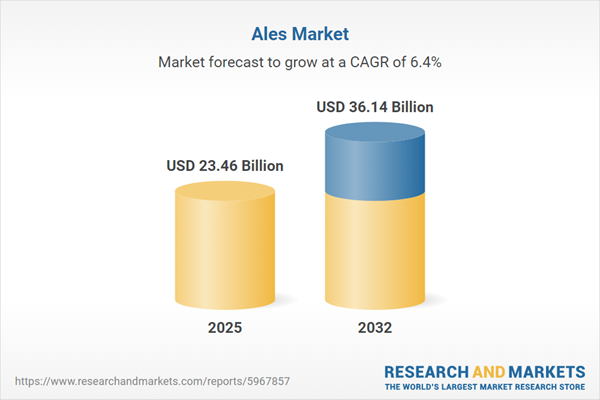Speak directly to the analyst to clarify any post sales queries you may have.
The U.S. ale market is experiencing notable shifts, influenced by consumer preferences, innovation in craft brewing, and evolving trade and regulatory dynamics. This report offers senior decision-makers actionable insights and strategic context to navigate an increasingly intricate industry environment.
Market Snapshot: Ale Market Size and Growth Outlook
The Ales Market is projected to grow from USD 22.05 billion in 2024 to USD 23.46 billion in 2025 and is expected to reach USD 36.14 billion by 2032, reflecting a CAGR of 6.36%. This sustained expansion is propelled by consumer demand evolution, the rise of craft brewing, and a competitive landscape characterized by both innovation and tradition. Industry stakeholders are navigating a complex playing field shaped by regulatory changes, shifting distribution channels, and a broadening suite of product offerings.
Scope & Segmentation of the Ales Market
Comprehensive segmentation enables targeted strategies and tailored product development decision-making. The report covers the following critical segments:
- Product Types: Amber Ale, Belgian Ale, Brown Ale, India Pale Ale, Pale Ale, Wheat Ale.
- Distribution Channels: Bars & Restaurants, Grocery Stores, Liquor Stores, Online Retail including direct website sales and third-party platforms.
- Packaging Types: Glass Bottles, PET Bottles, Slim Cans, Standard Cans, Tall Cans, Draught (Nitro-Infused, Standard Gas), Half Barrel Kegs, Mini Kegs, Quarter Barrel Kegs.
- Alcohol Content: High Alcohol, Low Alcohol, Standard Alcohol.
- Demographics: Baby Boomers, Gen X, Gen Z (casual drinkers, social media-savvy), Millennials (rural, urban).
- Regional Coverage: Americas (United States, Canada, Mexico, Brazil, Argentina, Chile, Colombia, Peru), Europe, Middle East & Africa (United Kingdom, Germany, France, Russia, Italy, Spain, Netherlands, Sweden, Poland, Switzerland, United Arab Emirates, Saudi Arabia, Qatar, Turkey, Israel, South Africa, Nigeria, Egypt, Kenya), Asia-Pacific (China, India, Japan, Australia, South Korea, Indonesia, Thailand, Malaysia, Singapore, Taiwan).
- Company Analysis: Competitive assessment includes Anheuser-Busch InBev, Heineken N.V., Carlsberg, Molson Coors, Tsingtao Brewery, Asahi Group, China Resources Snow Breweries, Kirin Holdings, Constellation Brands, Suntory Holdings.
Ale Market Key Takeaways for Senior Decision-Makers
- Growing consumer appetite for flavor diversity and product authenticity accelerates both innovation and niche differentiation across product lines.
- Health-driven preferences are spurring the development of low-alcohol and gluten-reduced ales, broadening the addressable market.
- Digital engagement, including direct-to-consumer channels and real-time analytics, is reshaping marketing and shortening go-to-market timelines.
- Sustainability initiatives, ranging from traceable ingredients to recyclable packaging, are increasingly influencing investor decisions and consumer choice.
- Strategic investments in domestic supply chain resilience and partnerships are helping mitigate risk from regulatory shifts and tariff-related price pressures.
Tariff Impact on Supply Chain and Competitive Dynamics
Recent tariff measures have heightened input costs for imported malted grains, specialty hops, and brewing equipment. Breweries are mitigating these effects through domestic sourcing, strategic consolidation, backward integration, and partnership models that bolster distribution and purchasing power. These adjustments are reconfiguring supply chain dynamics across organizations of all sizes.
Methodology & Data Sources
Findings are derived from a mixed-method research design combining secondary reviews of trade publications, regulatory updates, and annual reports with primary interviews conducted among brewery executives, procurement managers, distributors, and retailers. Quantitative and qualitative data were triangulated and validated through peer review, ensuring robust and actionable insights.
Why This Report Matters: Strategic Value for Decision-Makers
- Enables targeted investment and product development by highlighting fast-evolving consumer segments and emerging opportunities.
- Supports resilience planning through analysis of trade measures, supply chain risks, and adaptive production strategies.
- Provides regional and competitive intelligence for aligning marketing, operations, and partnership decisions with market trends.
Conclusion
Senior leaders can leverage this ale market analysis to refine strategy, manage risks, and capture growth in an increasingly interconnected and rapidly evolving sector. The report equips executives with context and clarity needed to drive informed decision-making and future readiness.
Additional Product Information:
- Purchase of this report includes 1 year online access with quarterly updates.
- This report can be updated on request. Please contact our Customer Experience team using the Ask a Question widget on our website.
Table of Contents
3. Executive Summary
4. Market Overview
7. Cumulative Impact of Artificial Intelligence 2025
Companies Mentioned
The companies profiled in this Ales market report include:- Anheuser-Busch InBev SA/NV
- Heineken N.V.
- China Resources Snow Breweries Co., Ltd.
- Carlsberg A/S
- Molson Coors Beverage Company
- Tsingtao Brewery Company Limited
- Asahi Group Holdings, Ltd.
- Kirin Holdings Company, Limited
- Constellation Brands, Inc.
- Suntory Holdings Limited
Table Information
| Report Attribute | Details |
|---|---|
| No. of Pages | 188 |
| Published | November 2025 |
| Forecast Period | 2025 - 2032 |
| Estimated Market Value ( USD | $ 23.46 Billion |
| Forecasted Market Value ( USD | $ 36.14 Billion |
| Compound Annual Growth Rate | 6.3% |
| Regions Covered | Global |
| No. of Companies Mentioned | 11 |









